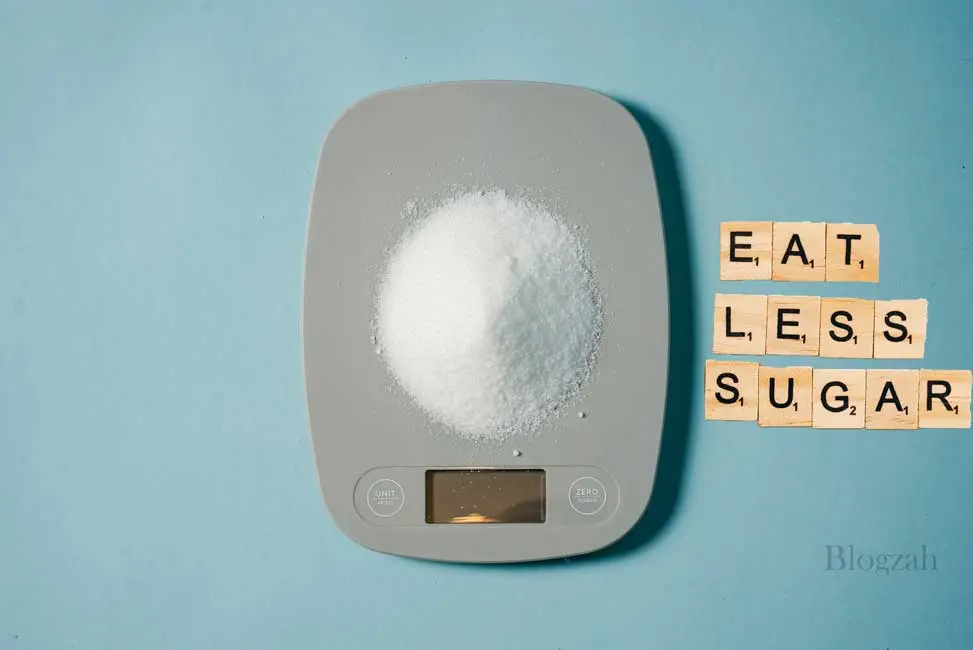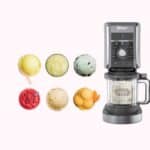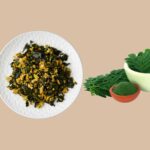Sugar can harm our health if consumed in excess hence reading product labels can be a helpful first step to eat less sugar.
According to the recommendation of the World Health Organization to reduce sugar intake, less than 10% of our daily caloric intake, equivalent to around 50 grams or 12 teaspoons of sugar daily.
However, most people consume much more than this, which can lead to various health issues, including obesity, type 2 diabetes, and heart disease. This article will discuss 25 practical ways to eat less sugar and improve your health.
Professionals review our articles to ensure the accuracy of the content.
Eat Less Sugar: 25 Practical Ways to Reduce Your Sugar Intake
1. Eat More Protein
Protein-rich foods, such as eggs, chicken, fish & legumes, can help you manage hunger and prevent cravings for sugary snacks.
They will help you stay fuller for longer due to their rich essential nutrients, providing amino acids required for muscle development and recovery.
Studies have found that consuming more protein than the recommended dietary allowance reduces body weight (BW) and enhances body composition by decreasing fat mass while preserving fat-free mass (FFM) in both low-calorie and standard-calorie diets 1.
In addition, the researchers found a moderately higher intake of protein, which is accompanied by a higher intake of green vegetables, and a reduced intake of refined grains and added sugar provided another benefit to the dieters: a reduced loss of lean body mass often associated with weight loss 2.
2. Drink Water
The simplest and most effective way to reduce your sugar intake and stay hydrated is to maintain regular water intake during the day because it helps you stay hydrated and provides vitamins, minerals, and electrolytes, which are essential to keep your body functioning correctly 3. Sugary beverages always promote weight gain, which may increase the risk of diabetes 4.
Some healthier alternatives to sugary drinks
- water
- unsweetened sparkling water
- herbal teas
- black or green tea
- coffee
“I have a sweet tooth, so I used to have lots of dessert. But I made a conscious decision to eat less sugar.” – Gwyneth Paltrow
3. Read Labels
When trying to cut your sugar intake, avoiding sugary treats is not enough because it is crucial to identify the amount of sugar in food like ketchup or granola. The US Food & Drugs Administration has also updated The Nutrition Facts label on packaged foods and drinks to make it easier for you to make informed choices 5.
The ingredients are usually listed on packaged foods and drinks from highest to lowest quantity of sugar, so if any ingredient appears in the top positions, they have more sugar than other items.
Some of the most common names of sugar
- high fructose corn syrup
- cane sugar or cane juice
- maltose
- dextrose
- invert sugar
- rice syrup
- molasses
- Caramel
4. Prefer Whole Foods
Whole foods aren’t processed, free from additives and artificial chemicals. Think fresh fruits, vegetables, legumes, grains, and meat – all of these can be included in whole foods.
However, processed foods have delicious tastes and are hard to resist as they contain high sugar, salt, fat, and other additives.
The American population is consuming an excessive amount of added sugars, which is 42 percent of their average daily calories 6. This contributes significantly to a host of health problems like weight gain and obesity, which in turn can increase the risk of developing other serious health conditions such as type 2 diabetes and heart disease 7.
However, the Dietary Guidelines for Americans 2020–2025 recommends that Americans 2 years and older keep their intake of added sugars to less than 10% of their total daily calories.
5. Use Natural Sweeteners:
Refined sugar has been associated with various health issues, like weight gain, diabetes, and heart complications. On the other hand, artificial sweeteners are also famous for those searching to reduce their calorie intake without immolating sweetness.
However, researchers have found that despite being calorie-free, artificial sweeteners can still trigger sugar desire and cause weight gain, brain tumours, bladder cancer and have a potential long-term adverse health impact 8. Thus, natural sweeteners like honey 9, maple syrup, and stevia are getting the first choice over sugar among fitness freaks due to fewer calories and additional nutrient benefits compared to refined sugar.
Additionally, they have a more complex flavour profile that can improve the taste of any food or drink. Consequently, natural sweeteners instead of refined sugar are a great way to enjoy the sweetness without compromising your health.
6. Try Savoury Breakfasts
Did you know that numerous breakfast foods can be filled with sugar? If you’re looking to make a healthier beginning to your day, try swapping out those sugary foods for savory options like Eggs, avocado toast, vegetable omelets, etc.
According to the media report, office-goers are still buying breakfast even as they cut back on other things, due to inflation, counting about 13% of total fast-food sales compared to the meals, which stood at 20% of restaurant transactions.
7. Pack Your Snacks
Eating on the go can be tricky, especially when finding healthy food options. However, it doesn’t have to be problematic. Having snacks is an easy and handy way to guarantee to get the nutrients you need without resorting to unhealthy options. Studies suggested that homemade snacks/meals might encourage moderated snacking behaviour & more structured mealtimes 10.
Nuts, seeds, and cut-up veggies with hummus and others are excellent choices when you’re out. Not only are they nutritious and delicious, but they’ll also help keep your energy levels up throughout the day!
8. Cook at Home
Cooking at home is a great way to control what goes into your meals, which gives you greater control over the ingredients and allows you to enjoy the taste of your homemade dishes, helping you to avoid added sugars in processed foods and choose nutritious ingredients instead.
Study shows that those consuming home cooked meals are 28% less likely to be overweight, and 24% less likely to have excess body fat percentage 11.
9. Choose Low-sugar Condiments
Condiments add more taste to your meals, but most store-bought varieties contain large quantities of sugar. Therefore, it is recommended to look for healthy condiment options or make your own using natural sweeteners, which will allow you to control the sweetness in each dish but also facilitate you to get the most out of your condiments while avoiding unnecessary sugar.
10. Use Spices and Herbs
Americans are contemplating the use of spices and herbs for medicinal and therapeutic purposes, especially to remedy various chronic conditions, reduce disease symptoms, and aid in treatment and management of common health problems 12.
From cinnamon and ginger to mint, coriander, and turmeric, these natural ingredients can transform an everyday meal into something extraordinary. These spices and herbs add taste to your meal without sugar, reduce inflammation, improve digestion, and have numerous health benefits.
11. Snack on Fruit
From juicy berries to crunchy apples and sweet oranges to many more, there is no shortage of delicious fruit options. So next time you’re looking for a snack, reach for some fruit instead! Because fruits are filled with essential nutrients like vitamins, minerals, and antioxidants that can help keep you healthy without the added sugar and calories that come with sugary snacks.
12. Choose Unsweetened Dairy
Although dairy products are a nutritious source of protein, several flavoured yoghurt and milk contain high levels of added sugars 13. It is essential to read labels and choose unsweetened options to avoid consuming high sugar. As an alternative, add fruit or natural sweeteners for sweetness to avert consuming extra calories.
13. Watch Out For Hidden Sugars
Knowing how much added sugar is in our food is cumbersome but essential. The good news is that many low-sugar options are available in the market to keep your sugar intake under control. Read labels carefully to identify healthier choices for you and your family.
14. Practice Mindful Eating
Enjoy every flavour of your meals by eating them slowly. It profoundly impacts your overall health and well-being 14 because when you pay attention to what you eat and how quickly you do so, you can prevent overeating and ensure that your body receives the nutrients it needs.
15. Don’t Skip Meals
Skipping meals is not dieting, but having regular meals and snacks throughout the day is essential for maintaining a healthy diet. According to recent research, US adults who skip meals may be placing themselves at an elevated risk for all-cause and cardiovascular disease mortality. It increases cravings that will lead to overeating, causing weight gain, fatigue, and even mood swings, raising the risk for all-cause and cardiovascular disease mortality while eating regular meals keeps your energy levels up and makes you feel fuller for more extended periods that help prevent your unhealthy cravings.
16. Choose Dark Chocolate
Dark chocolate has lower sugar than other sweets; thus, it is considered a perfect, delicious, healthy snack option. In addition, it also contains high levels of cocoa, which provides considerable health benefits.
Indulging in a bit of dark chocolate might have more benefits than just satisfying your sweet tooth. Emerging research proposes that this velvety treat could potentially lower the risk of heart disease, reduce inflammation and insulin resistance, enhance the diversity of the gut microbiome, and even give a boost to your brain function 15. So, next time you reach for that decadent square of darkness, know that you might be doing your body and mind a favor.
17. Limit Alcohol
Alcohol is high in calories and sugar 16. Pick lower-sugar options such as wine or spirits with sugar-free mixers. It is essential to be mindful of the amount you are consuming and limit your calorie and sugar intake while enjoying a drink.
18. Swap Out Sugary Treats
Eating healthy shouldn’t be a chore. Minor changes to your snacking habits can significantly impact your overall health and wellness 17. Instead of reaching for candy or cookies, try swapping them out for healthier options, such as fruit, nuts, or a small piece of dark chocolate. These options are packed with essential nutrients and vitamins to satisfy your cravings without sacrificing flavor.
19. Try Sugar-Free Baking
Bake tasty muffins and cookies with ingredients like bananas and applesauce for healthier and more flavorful alternatives than their sugary counterparts. The World Health Organization has proposed to reduce the daily calorie intake through sugars for the health benefits of human beings to 5% from the earlier recommended level of 10% 18. And sugar-free baking can help reduce the daily calorie intake through sugars.
Plenty of recipes in the market are made of natural sweeteners. So, enjoy delicious baked goods without the added sugar.
20. Choose Low-Sugar Snacks
Healthy snacks are a vital part of maintaining a balanced diet. However, many snack foods, such as chips and crackers, contain high sugar levels. Popcorn, rice cakes, etc., can be perfect due to their lower sugar and delicious taste 19. Enjoy such delicious snacks without worrying about the amount of sugar in your diet.
21. Cut Back On Processed Foods
With high sugar and unhealthy ingredients, processed foods are detrimental to maintaining a balanced diet. So, it’s good to focus on eating more whole foods and cooking at home as much as possible to stay healthy and nourished. Whole foods 20 are loaded with essential vitamins and minerals, providing the body with all the nutrients without added sugars or preservatives. Whole foods aren’t processed, free from additives and artificial chemicals. Think fresh fruits, vegetables, legumes, grains, and meat – all of these can be included in whole foods.
22. Avoid Sugary Breakfast Cereals
It is hard to find cereals that contain both nutrition and low sugar. Many cereal brands are deceivingly marketed as “healthy” or “low-fat” but contain high sugar. On the other hand, several other cereal brands have excess added vitamins and minerals, which seem like a healthy perk but do more harm than good 21. Make sure to check the nutrition label to avoid being deceived. Look for cereals with less than 5 grams of sugar per serving to ensure you get the most nutrition from your breakfast, or choose the whole-grain options for high fiber and low added sugars.
23. Plan Your Meals
Planning for meals is a great way to expand healthier choices and stick to your nutrition goals. It will help you avoid the temptation of sugary snacks and meals loaded with empty calories. In addition, it allows you to save time and energy throughout the week, as you don’t have to worry about what you’ll eat or how much time it will take to prepare it.
24. Get Enough Sleep
Cravings and overeating may also result from lack of sleep, which increases hunger hormones. Sleeping 7-9 hours per night reduces cravings and makes it easier to resist unhealthy food choices. Studies 22 have shown that consistently not getting enough sleep has been linked to a shorter lifespan. So, if you’re looking to live a long and fulfilling existence, don’t underestimate the power of a good night’s rest. It might just be the key to unlocking a healthier and happier you.
25. Be Patient
Reducing your sugar intake can be a challenging process, but it can also be advantageous. You can gradually reduce your sugar intake and create healthier habits with patience and dedication. Taking small steps and celebrating each milestone on the journey to better health is important.
A Word by Blogzah
The human body operates at its best without requiring carbohydrates derived from added sugars. As a general rule, it’s wise to steer clear of items that contain copious amounts of added sugar, even skipping those that list “sugar” as one of their top two ingredients. It’s worth noting, however, that a diverse range of sweeteners may be employed in these products, so it’s essential to review the complete ingredient list meticulously. Fortunately, the updated Nutrition Facts label in the United States features a distinct line for “added sugar,” making it a breeze to distinguish between sugar that’s been added artificially and naturally occurring.
















